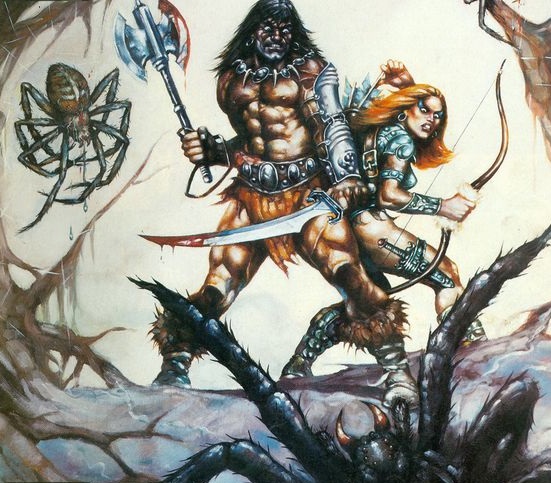Last week, we looked at storyworlds’ premise: that is, their tones, settings, characters, and conflicts. We specifically looked at this these things through the lens of my in-progress storyworld that doesn’t yet have a name, but is does have a whole lot of giant spiders.
Today, I’d like to focus on characters in storyworlds.
Back when dinosaurs roamed the earth and Trump was just a second-rate reality TV star, I wrote that we should focus on character archetypes rather than specific characters, and that those archetypes should ideally be unique to our storyworld.
Huh. Past-me was pretty smart about this stuff. Let’s take his advice, apply it to our spider-filled storyworld, and see what we can come up with for character archetypes.
The Good
Road Warriors: Before the arachnid invasion, the roads between cities were kept safe from bandits and other hazards by brave defenders who patrolled the highways on the backs of specially-trained tigers. Most of these warriors were killed during the invasion, but a number still roam the region, helping fight against the invaders’ tyranny where they can.
Priests of the Silent Gods: When the arachnids invaded, many turned to the gods for help. But the gods, who were capricious at the best of times, remained silent even as the invaders destroyed their temples and enslaved their people. Still, there are those clergy who keep the faith and work small miracles to keep their flock as safe as they can.
Citizen Soldiers: There were few professional soldiers in the land before the spiders came. Now that they’re here, there are but two true professions left: soldier or slave. Former peasants have turned their tools into weapons, and use their knowledge of the land to strike quickly, then vanish. Former nobles use their voice of authority to lead in battle. Former merchants turn their skills towards acquiring food, weapons, and other supplies for the resistance. These difference classes of people had little in common, and are still prone to friction and resentment, but now fight side by side.
The Bad
Traitorous Nobles: The invaders don’t want to destroy the people of the realm, but to enslave them. To this end they have recruited many nobles to serve as puppet rulers. Some nobles are ridden by spiders who cling to their backs and telepathically put thoughts into their heads. Others are more willing accomplices; they offer up their peoples’ lives in exchange for their own safety and well-being. In the eyes of the resistance, these traitors are worse than the spiders themselves, and deserve no mercy.
Spider Riders: The spider army includes humans in it. Whether they are mind-controlled thralls, willing traitors, or something else entirely remains to be seen. These warriors are wrapped in silk robes and strange armor, and don’t seem to speak. They ride spiders into battle and serve as the hands of their fingerless masters.
Raiders: The invasion has all but destroyed law and order in the land. Armed men have taken advantage of the situation to pillage and conquer themselves. These gangs of brigands make travel dangerous even outside the occupied zones. They would make excellent allies to the resistance, but would rather carve out their own brutal fiefdoms in the ruins of this once-great land.
The Ugly
Alchemists: I mentioned previously that magic in the land is largely in the form of potions. Alchemists are the ones in charge of such things, and they are an odd lot. Sticking with the classic sword and sorcery tradition, alchemists are reading from the mad scientist handbook; they typically work alone on projects of questionable ethics, are rich or have rich patrons, and are often mentally unstable. Some work for the resistance, some for the spiders, and some ignore the occupation altogether while perfecting their formulas in hidden laboratories.
The Broken: Those who the spiders don’t kill, they enslave. Some are ridden by mind-controlling spine-spiders, but most are simply forced to work the fields and forges under the watchful eyes of their arachnid overlords. To be fair, many of them weren’t much worse off under the old nobility. But at least their human lords were less likely to snatch up their loved ones seemingly at random. While most of those taken by the spiders simply vanish, some are immediately eaten, and their desiccated corpses are dropped where ever the spider happens to be when it’s done feeding.
Smugglers: A loose network of smugglers ensures that there is steady, if secretive, traffic between the spider-held lands and the embattled free regions. They sneak weapons, luxury goods, and resistance spies into the occupied territories, then sneak escapees (and more spies) out again. Smugglers always have a price. Some have a soft spot for the resistance, but they know that if the spiders are driven out, the smuggling business will dwindle to nothing.
Whew! That was longer than expected. Come back later this week as we examine the last part of the premise: conflict.

